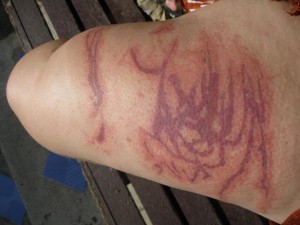A jellyfish sting usually leads to the inflammation of the affected region of the skin due to the venom released from the jellyfish. Jellyfish have cysts containing venom in their tentacles. When a person’s skin comes into contact with the tentacles of the jellyfish, the cysts may inject venom into the person’s skin.
The venom may cause the inflammation of the underlying tissue beneath the skin and inflammation of the skin as well. Jellyfish stings are usually very painful, however; symptoms are often short-lived and last for only 7-10 days. Death rarely occurs from jellyfish stings.
Important Disclaimer: The material posted on this page about jellyfish stings is for information purposes only. Learn how to recognize and manage victims of poisonings by enrolling in St Mark James first aid and CPR courses.
Jellyfish facts
- Jellyfish have tentacles which have cysts containing harmful venom
- Contact with the tentacles and thus the cysts, may cause the venom to enter the skin
- The venom will cause inflammation of the skin and underlying tissues once it is injected into the casualty
- Venom can also get absorbed into the bloodstream, which may lead to toxic results, affecting the liver, kidneys, nerves and heart
- Usually the venom causes allergic reactions to occur in the victim
Signs and symptoms of jellyfish stings
Signs and symptoms of jellyfish stings include:
- Pain around the affected region of the skin
- Redness of the affected region of the skin
- Blisters on the skin
- Tenderness of the skin
- Swelling of the affected region
- A localized rash may also appear on the skin
Major symptoms of jellyfish stings that should be reported to the emergency room include:
- Chest pain
- Breathing difficulty
- Wheezing
- Diarrhea
- Muscle pain
- Muscle weakness
- Muscle spasm
- Overactive salivary glands – excessive salivation
- Vomiting
- Faintness
- Fainting
Treatment
Call 911 and follow the steps given below:
1. Get the victim out of the water immediately, if it is safe for you to do so
2. Control stinging
- In case of a jellyfish sting in non-tropical waters, wash the affected region with saltwater to neutralize the sting
- In case of a jellyfish sting in tropical waters, rinse the affected region with vinegar immediately. Do NOT use tap water or fresh water as it may worsen the stinging and activate the stinging cells again
- Continue rinsing the affected region until medical help arrives
3. Remove the tentacles and decontaminate the affected region of the skin
In case of stings not caused by box jellyfish, follow these steps:
- Apply vinegar on the affected are for half an hour
- You may use soap lather, shaving cream, a paste made of sand/mud and seawater, if vinegar is not available
- Next, use a tool that can be used for scraping such as a credit card or a razor, if available to scrape off the stinging cells from the skin
- Apply vinegar again
4. Control swelling and itching
- Over-the-counter antihistamines or a mild hydro-cortisone can be taken to relieve swelling and itching
Learn More
To learn more about Jelly fish stings and how to manage these and other poisons enrol in St Mark James first aid and CPR courses (register here) with one of our credible providers. Search through our locations page to find a provider near you.
